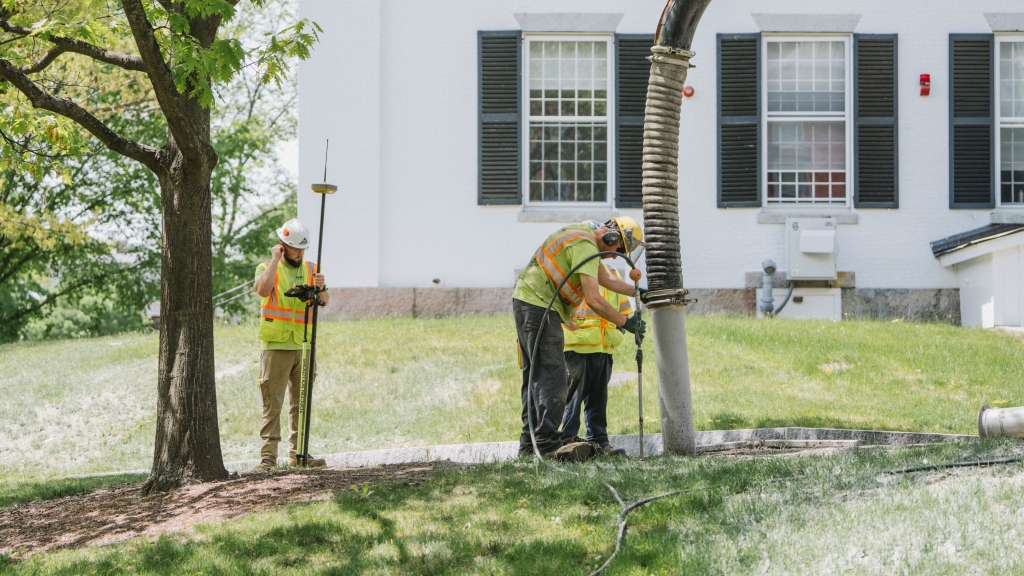Construction to shift Dartmouth's steam-based energy systems away from fossil fuels is set to begin June 17 with the installation of piping and electrical duct banks in multiple locations that will enable the transition from steam to hot-water heating using geo-exchange technology.
The work follows President Sian Leah Beilock's April 22 announcement of the Dartmouth Climate Collaborative, a commitment to address climate change and sustainability on campus and beyond.
"This is breaking new and important ground in our efforts to meaningfully address climate change and sustainability at Dartmouth," says Josh Keniston, senior vice president of capital planning and campus operations.
"Dartmouth's aging infrastructure—some of which is more than 100 years old—is in dire need of repair and modernization. Rather than sinking resources into outdated and inefficient systems, we will take this opportunity to reduce our carbon footprint in a lasting way through a comprehensive geo-exchange system."
Dartmouth's long-term energy plan will change how the campus is heated, cooled, and powered, by reducing energy consumption, constructing highly efficient new buildings, and transitioning to low-carbon energy sources. The addition of an expanded geo-exchange system to the campus energy technology portfolio will help meet Dartmouth's energy needs without generating operational carbon emissions.
The campus-wide decarbonization project will shift Dartmouth away from fossil fuels with the goal of reducing campus emissions by 60% by 2030 and 100% by 2050.
Geo-exchange systems, which use a closed loop network of fluid-filled pipes in boreholes to harness the earth's ambient temperature (consistently at about 50 degrees Fahrenheit), are effective in regions, including the Northeast, which have significant seasonal temperature changes. The boreholes are drilled roughly 800 feet into the earth's surface and work in tandem with a heat pump to pull warm air out of buildings in the summer to make them cooler. That warm air is transferred to hot water that can either be repurposed right away or sent to the geo-exchange bores to be saved for later use. In colder months, the system can leverage ambient ground temperatures to efficiently deliver heat to where it is needed.
A new Dartmouth Decarbonization website further explains the technology and work associated with building a geo-exchange system. The site provides a project timeline and outlines steps that Dartmouth is taking to reach carbon zero by 2050.
Construction of the geo-exchange system will be completed in phases over the next several years. The first phase includes installing piping and conduits beneath specific sidewalks and pathways so campus buildings can eventually be connected to the system. Initial work will require digging trenches up to 14 feet wide and 10 feet deep for the piping and conduits. Sections of work will be connected by underground vaults, which will contain valves necessary for the hot water distribution system.
Work is planned to start on June 17 in the following locations:
- The intersection of East Wheelock Street and College Street, where pipe will be installed beneath College Street. A portion of College Street will be under construction by the town of Hanover for paving and sewer work, and the piping work will occur at the same time. Some closures of College Street are expected.
- The New Hampshire Hall side of East Wheelock Street, where the first vault will be installed. The second vault will be at the corner of East Wheelock and Crosby streets, and the third will be adjacent to the sidewalk from Berry Sports Center to East Wheelock Street. All excavations, which will be 24-feet square and 10-feet deep, will be well-marked and protected.
- At East Wheelock Street, road-crossing work is scheduled to take place from 8 p.m. to 6 a.m., at College and Crosby streets and the Berry complex. The town may detour traffic in the area.
- On Ivy Lane, near 17 and 19 East Wheelock Street, and behind Zimmerman and McCulloch Halls, some related work has begun, and temporary road closures are expected.
- On the road running between Fayerweather Hall and Wentworth, Dartmouth, Thornton, Reed, and Bartlett Halls.
- On a section of the alley running behind Berry and Alumni Gym, which will impact parking in the gym lot.
Work will be done in sections, and minor disruptions will include sidewalk and crosswalk closings and occasional minor impacts to traffic patterns. While efforts are being made to reduce the impact across campus, some benches and bike racks will be temporarily removed, and some landscaping will be affected. Specific attention is being paid to trees, and the campus arborist has been consulted to determine whether certain trees can be preserved and replanted in front of Topliff Hall and Alumni Gym. Efforts are being made to avoid impacting elm trees in this area.
Over the summer, piping and conduit work will follow East Wheelock Street to Crosby Street and cross over to the south side of East Wheelock in front of the tennis courts and Alumni Gym. Work will continue through the fall, with the drilling of some geo-exchange boreholes expected to begin in November. The boreholes will be placed near new heat pump plants and will store the heat captured by the geo-exchange system.
The 110 buildings at Dartmouth comprise more than 5.5 million square feet, and many are more than 100 years old, creating a challenge to effectively and efficiently heat and cool. The decarbonization plan has been envisioned for several years and will tie into many current and planned renovation projects—including those at several residence halls over the coming years.
In her April announcement, President Beilock said Dartmouth will invest more than $500 million in capital improvements over the next five years to accelerate campus decarbonization efforts and meet new carbon goals.
Construction schedules, updates, and maps of the affected areas can be found on the Campus Services website. Updates will be provided as work progresses, and social media posts will regularly highlight impacts on pedestrians, cyclists, and motorists, as well as other issues, such as temporary changes to some entryways to buildings.
